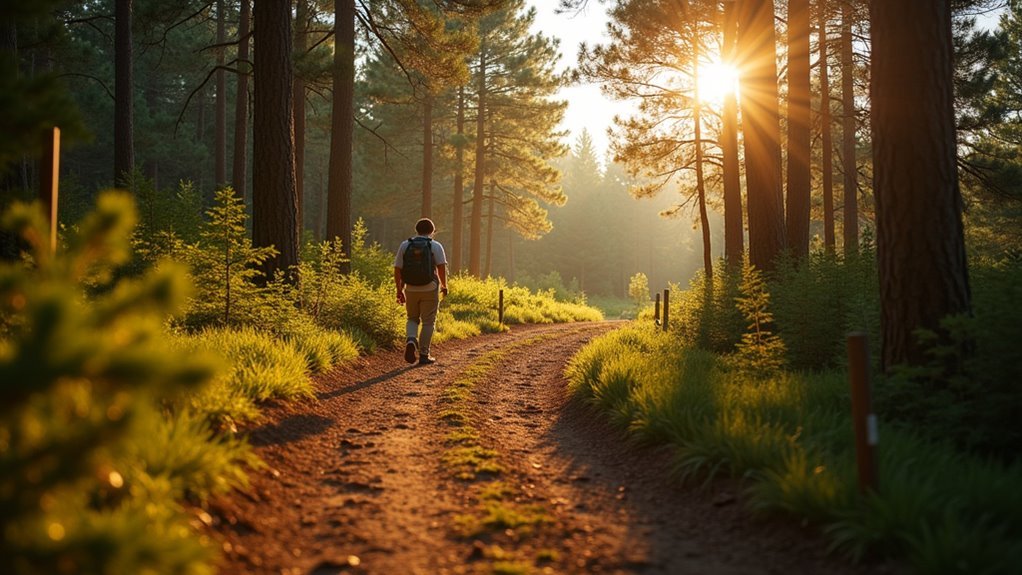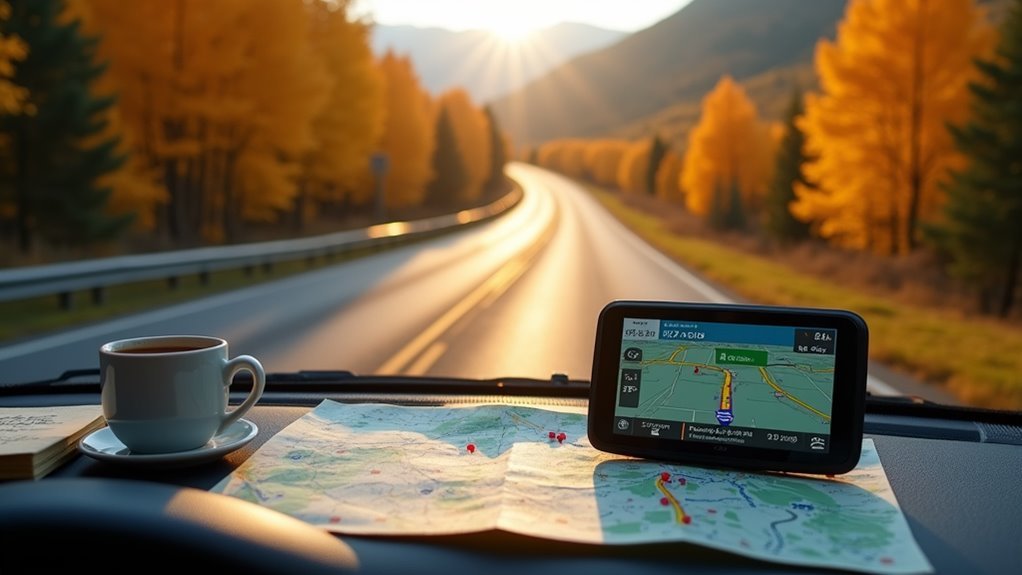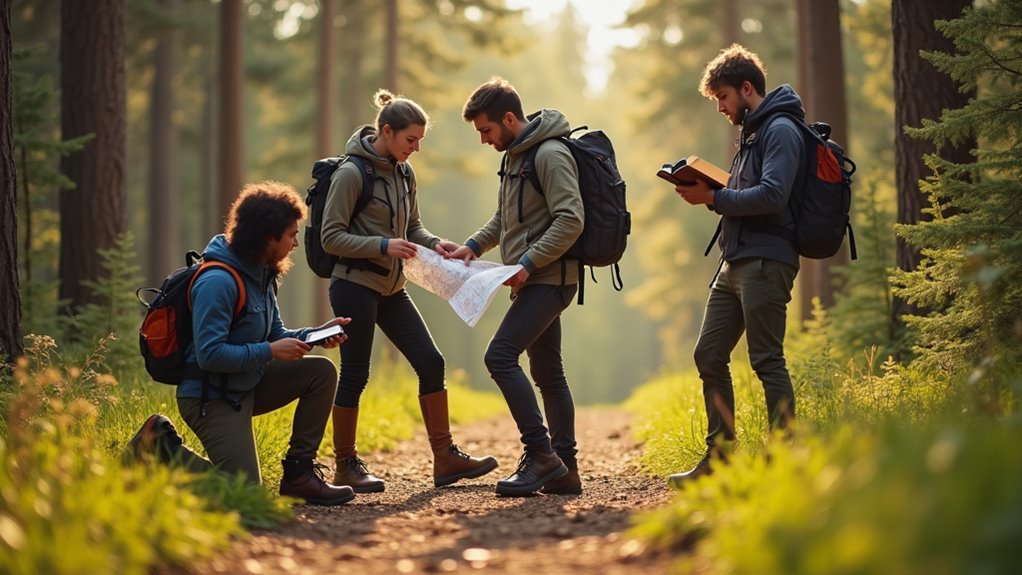Some of the links in this article may be affiliate links. If you make a purchase through these links, we may earn a small commission at no extra cost to you. Thank you.
Last summer, I tackled the ET Highway power trail in Nevada—526 caches in two days with my geocaching buddy Mike. I’ll never forget how unprepared we were for that first morning when temperatures dropped to 28°F! Power trails require specific strategies that differ from casual caching. I’ve since refined my approach through trial and error on dozens of high-volume routes. Want to know how to hit 100+ finds per day without burning out? The secrets aren’t complicated, but they make all the difference.
What Defines a True Power Trail?

What exactly makes a power trail “true” in the geocaching world?
In my experience, it’s about volume and efficiency.
A true power trail consists of at least 50 caches (though some purists might argue 25 is the minimum) placed at least 528 feet apart along a drivable route.
A true power trail delivers at least 50 caches spaced precisely 528 feet apart along easily drivable routes—efficient geocaching at its most calculated.
I think of true power trails as the fast food of geocaching – they’re not about the quality of individual experiences but the quantity you can log in a day.
You’ll typically find small or micro PNG caches with low difficulty ratings that you can grab quickly, often without fully exiting your vehicle.
The ET Highway in Nevada with its 1,021 caches is probably the ultimate example.
It’s like geocaching on steroids – minimal effort, maximum finds!
Preparing Your Equipment for High-Volume Caching
Now that we’ve established what makes a true power trail, let’s talk gear. Your GPS receivers need to be fully loaded with waypoints and updated firmware—trust me, you don’t want to be fumbling with downloads when facing 1,000+ caches on the ET Highway.
I’ve learned the hard way that weather prep is essential.
Pack layers that can handle anything from -7 to 50 degrees.
Actually, make that -10 to 50… temperatures can be even more extreme than predicted.
Don’t forget a multi-tool for those tiny film canisters that become nearly impossible to open with cold fingers.
Extra batteries or portable chargers are absolute musts—nothing worse than your GPS dying halfway through a 386-cache day.
Oh, and extra fuel containers? They’re lifesavers on remote trails.
Developing an Efficient Driving Route Strategy

When I’m planning my route for power trails, I always start with careful map preparation to avoid the dreaded backtracking that can waste precious finding time.
I’ve learned from experience that planning bathroom and rest stops strategically along the route is just as important as plotting the caches themselves – nothing kills momentum like an unexpected 20-minute detour.
You’ll want to evaluate both main driving segments and the smaller walking paths between cache clusters, making sure you’re maximizing your finds per hour rather than your miles driven.
Map Preparation Tactics
Planning your route before hitting a power trail can mean the difference between success and frustration. I’ve found that proper map preparation is absolutely essential when tackling those epic trails like ET Highway. What I do is download offline maps and mark key decision points before heading out.
| Preparation Step | Time Required | Benefit |
|---|---|---|
| Download offline maps | 15-30 mins | Works without cell service |
| Mark fuel stops | 10 mins | Prevents unexpected detours |
| Identify trail intersections | 20 mins | Minimizes backtracking |
| Plot sub-trail connections | 15 mins | Maximizes cache counts |
| Calculate time gaps | 10 mins | Realistic expectations |
You’ll want to connect nearby trails when possible – I learned this the hard way on Blue Hills when I missed the perfect connection to Harris Felsenmeer. Trust me, your future self will thank you!
Minimizing Backtracking
How efficiently you navigate between cache locations can dramatically impact your overall power trail experience.
I’ve found that loading all caches into my GPSr before starting and following a predetermined order is absolutely critical for trails with significant power.
When I developed my route for the ET Highway, I planned each segment meticulously, defining clear start and end points to maintain a linear path.
Trust me, you don’t want to experience that frustrating 45-minute gap between finds that I once had because I overlooked driving time!
For lengthy trails, I always integrate fuel stops into my route planning—sometimes even carrying extra fuel containers.
It’s like playing chess; you’ve gotta think several moves ahead to avoid the exhaustion that comes from unnecessary backtracking.
Bathroom Break Planning
Beyond route planning lies another aspect of power trailing that’s often overlooked until it’s too late—bathroom breaks.
I’ve learned the hard way that efficient Geocaching Power trails require strategic bathroom planning.
When tackling massive trails like the ET Highway with its 1,021 caches, I always incorporate fuel stations into my route as designated rest stops.
Trust me, maintaining hydration while keeping up your find rate demands this attention to detail!
I typically plan breaks every 50-100 caches, using my GPS to identify convenient stopping points along the way.
On my team, we’ve worked out a system where the driver handles navigation while others take quick turns at rest stops.
This approach—which, honestly, took us a few frustrating trials to perfect—keeps us moving efficiently without compromising on comfort or safety.
Team Roles and Responsibilities on the Trail

When I’ve led power trail teams, I’ve found that balancing driver-finder roles creates a seamless experience where each person knows their responsibilities.
You’ll want to rotate positions every few hours to prevent fatigue and keep everyone’s energy levels up throughout the day.
Clear communication between drivers and finders isn’t just helpful—it’s absolutely essential for maintaining efficiency and preventing those frustrating moments when someone’s left wondering what to do next.
Driver-Finder Dynamic Balance
The success of any power trail expedition hinges on a well-orchestrated driver-finder dynamic. I’ve found that when roles are clearly defined, you’ll zip through caches along the route with remarkable efficiency.
As a driver, your focus should remain on safe navigation and route planning, while finders handle the physical retrieval of containers.
This balance isn’t just about speed—it’s about sustainability over a full day of caching.
In my experience, the best teams develop intuitive communication systems.
When I’m driving, I appreciate finders who proactively report traffic conditions while I concentrate on the next coordinates.
Similarly, when I’m finding, I try to minimize time spent out of the vehicle.
Rotation Prevents Fatigue
Speaking of teamwork, I’ve observed that maintaining stamina throughout a power trail boils down to one core strategy: rotation.
When tackling routes with hundreds of caches, the constant in-and-out of vehicles can drain even seasoned cachers.
I’ve learned—sometimes the hard way—that switching between driving and finding roles keeps everyone fresher.
On the Bear Bait Trail, my team completed 11 hours without hitting the wall because we traded responsibilities.
The driver handles navigation while finders manage retrieval and logging, then we swap.
This approach isn’t just about physical relief; it’s mental too.
Tracking your finds per hour while rotating helps monitor energy levels.
Plus, it creates natural opportunities to hydrate and snack—absolutely essential when you’re aiming to clear something like the Blue Hills Trail in a day.
Communication Maintains Efficiency
How effectively your team communicates can make or break a power trail adventure. In my experience, clear role definition and real-time information sharing saves precious time when you’re aiming for maximum finds per hour.
| Role | Primary Responsibility | Communication Task | Time-Saving Benefit |
|---|---|---|---|
| Driver | GPS navigation | Share FPH stats | Route optimization |
| Finder | Locate caches | Alert to hazards | Reduced search time |
| Support | Handle logistics | Coordinate breaks | Sustained energy |
| All | Role rotation | Status updates | Prevent fatigue |
I’ve found that when finders quickly communicate issues like frozen containers, we waste less time at each stop. And when my team keeps me (as driver) updated on traffic conditions, I can make split-second routing decisions. Maybe the most valuable communication happens when someone simply says, “I need food” before they crash.
Physical and Mental Endurance Tactics
Why do many geocachers underestimate the sheer exhaustion that comes with power trails?
I’ve seen teams tackle a large number of caches without proper preparation, only to burn out halfway through.
Finding 150 caches in a day sounds thrilling until you’re on your 87th in-and-out of the car with shaky legs!
The adrenaline fades fast when your wobbling knees remind you that geocaching marathons demand more than enthusiasm.
Trust me, the physical toll is real.
To keep your stamina up, I’d recommend:
- Drink water constantly, not just when thirsty – dehydration creeps up quickly
- Pack small, frequent snacks rather than planning for “lunch later”
- Track your Finds Per Hour to pace yourself – this isn’t a sprint!
Container Types and Quick Identification Methods
I’ve found that knowing your container types can make or break your power trail experience—when I’m hunting micro caches, I look for those telltale magnetic mounts that stick out against natural backdrops.
You’ll save precious minutes by training yourself to recognize container shapes quickly, especially those tiny Bison tubes that blend into their surroundings.
While mag mounts are my go-to for urban trails because they’re faster to spot, traditional containers like film canisters actually offer better protection and visibility when you’re racing through wooded power trails.
Micro Container Design Hacks
Three essential micro container types dominate the power trail landscape, and knowing how to spot them quickly can dramatically boost your cache-per-hour rate.
In my experience, Bison tubes are the kings of power trails due to their durability and compact size—I’ve seen them everywhere from the Blue Hills Trail to the massive ET Highway series.
When I’m hitting a power trail in winter, I always watch out for those 35 mm film canisters since they can be a real pain to open at -7°C.
- Standardize your container expectations based on trail descriptions (like the ET Highway’s consistent micro sizing)
- Look for the distinctive shape of Bison tubes against natural backgrounds
- Use cache hints religiously—they’re practically mandatory for power trails with 300+ cache containers
Container Recognition Speed
While racing through a power trail at top speed, your ability to quickly recognize container types can make the difference between finding 20 caches per hour and hitting 40+. I’ve learned that training your eye to spot specific containers can save a short amount of time with each find, which adds up tremendously throughout the day.
| Container Type | Recognition Clue | Typical Location |
|---|---|---|
| 35mm Film Canister | Cylindrical, black/gray | Base of signs, stumps |
| Bison Tube | Metallic shine, small | Magnetic surfaces |
| Micro Cache | Unnatural bump/bulge | Cracks, under objects |
When I’m blazing through Buckhorn Run or similar trails, I don’t waste precious seconds checking every nook. Instead, I’ve memorized the visual signatures of common containers. This pattern recognition becomes almost instinctive with practice—your brain starts flagging anomalies automatically!
Mag Mounts Vs Others
When comparing container types on power trails, magnetic mounts (or “mag mounts” as we veterans call them) absolutely dominate the efficiency game.
I’ve found that they cut my search time drastically compared to those frustrating 35mm film canisters that seem impossible to open when it’s cold out!
- Mag mounts stick to metal surfaces instantly, letting you spot and grab caches without leaving your car on roadside power trails
- Traditional containers like bison tubes require physical searching and handling, which honestly kills your FPH rate
- In winter conditions especially, mag mounts are game-changers—no more fumbling with frozen fingers trying to unscrew tiny containers
Trust me, if you’re serious about power trailing, magnetic containers will revolutionize your experience.
You’ll spend less time searching and more time logging finds.
Weather Considerations and Seasonal Planning
How dramatically the elements can impact your power trail experience!
I’ve learned the hard way that temperatures swinging from -7°C to a scorching 50°C can make or break your caching day.
Trust me, there’s nothing worse than struggling with a 35 mm container with frozen fingers along the trail.
I always check the forecast now and dress in layers—it’s just smart planning.
You know, I think scheduling power trails during milder seasons actually increases my finds-per-hour rate.
When it’s too cold or blazing hot, I’m focusing on survival instead of caching!
Regional weather patterns matter too.
Maybe skip those winter trails if freezing temps are common in your area.
Why battle the elements when you could cache comfortably another time?
Log-Signing Shortcuts and Etiquette
The weather’s not the only thing that can slow down your power trail pace—log signing might be the biggest time sink you’ll face!
When you’re targeting dozens or even hundreds of caches in a day, every second counts.
I’ve found that adopting paperless caching approaches can dramatically speed things up while still respecting the game’s integrity.
Here are my go-to shortcuts that won’t ruffle feathers:
- If you’re in a team, agree beforehand if one person can sign for all (using the team name) when others have seen the container
- For vehicle-accessible caches, keep your pen ready and log partially out for quick signing
- Take a quick photo of challenging logs, then move on—you can record your visit later in the app
Tracking Your Progress and Maintaining Motivation
Throughout a long day on the power trail, keeping tabs on your progress isn’t just satisfying—it’s practically essential for success.
I’ve found that tracking my finds per hour (FPH) allows cachers to find their rhythm and make necessary adjustments to complete ambitious trails like Blue Hills within planned timeframes.
Setting daily milestones works wonders for my motivation.
When I heard about Minnesotans logging 150 finds in a single day, I started celebrating my own mini-victories along the way.
Trust me, it makes a difference!
I always use my GPS to monitor cumulative counts, similar to the team that conquered Bear Bait Trail in just 11 hours.
Mixing up cache types—traditional, mystery, multi—prevents the dreaded power trail burnout that, well, we’ve all experienced at some point.
Notable Power Trails Worth Attempting
Now that you’ve got your tracking techniques down, let’s talk about some power trails that’ll really put them to use!
While the legendary ET Highway with its 1,021 caches has been archived (sadly for us numbers hunters!), there are still fantastic options out there.
- Blue Hills Trail offers 386 caches across 45 miles with a mix of difficulty levels—perfect if you’re looking for variety rather than just quantity.
- Buckhorn Run is smaller but mighty with 29 diverse caches—I think it’s ideal for power trail beginners.
- Bear Bait Trail requires more physical effort but can be conquered in about 11 hours with a team—bring friends!
In my experience, the best approach is to start with smaller trails like Hangm High before attempting something massive.
Your geocaching skills will thank you!
Frequently Asked Questions
Is Geocaching Still a Thing in 2025?
I’m seeing thriving Geocaching relevance in 2025, with active forums boasting hundreds of thousands of posts, recent trackable updates, and dedicated Patreon communities still supporting the hobby.
What Geocache Has the Most Finds?
I believe GC1169 (Project APE Cache – Tunnel of Light) holds the CacheRecords for most finds, though some ET Highway power trail caches had extraordinary numbers before being archived.
What Is a Power Trail Geocaching?
A power trail is my term for a series of geocaches placed along a linear route, allowing you to find many caches quickly to boost your find count efficiently.
Is Taking Geocaches Illegal?
Yes, taking geocaches without permission is illegal. I’d consider it Cache Theft since you’re removing someone else’s property. You’re only supposed to find, sign, and leave caches intact.